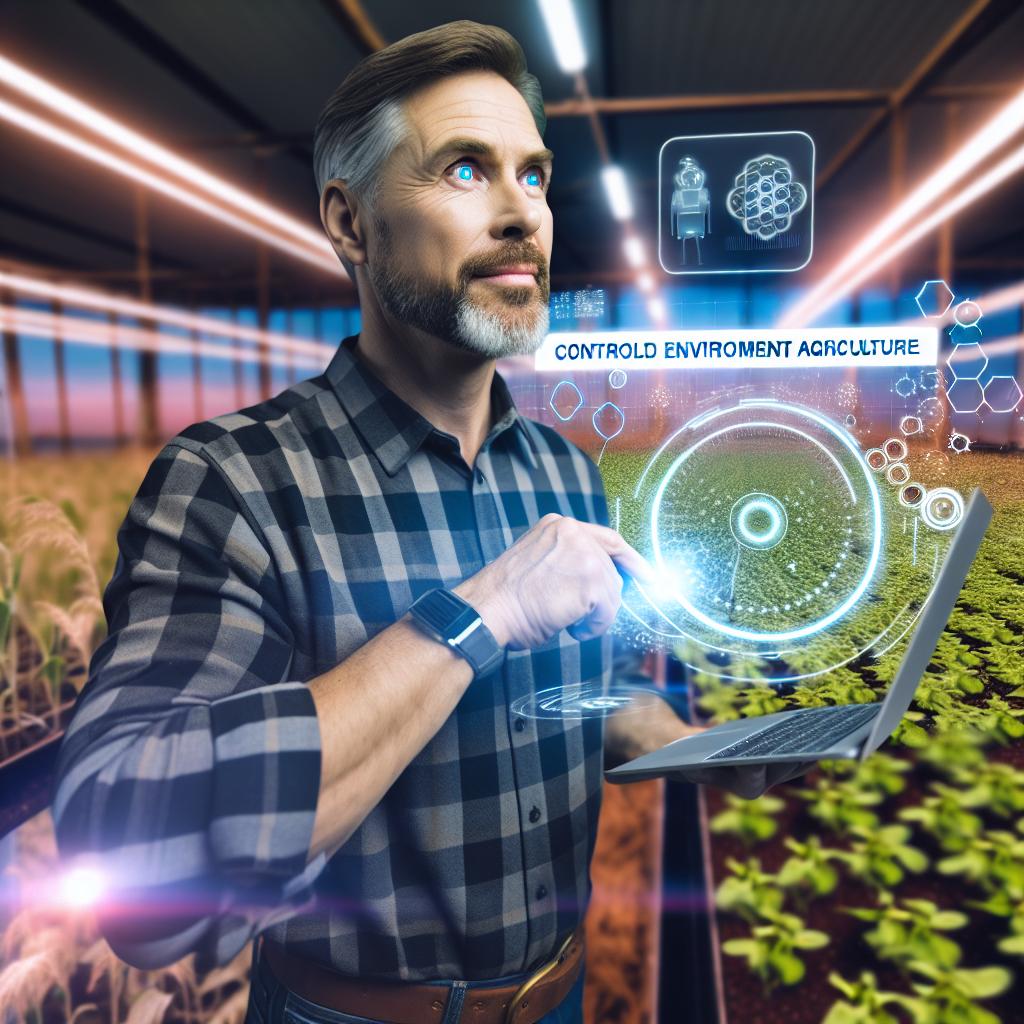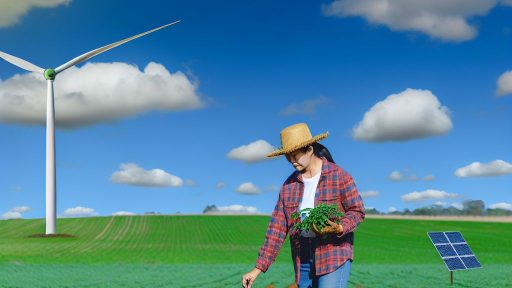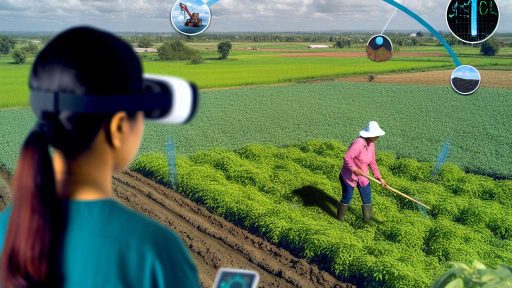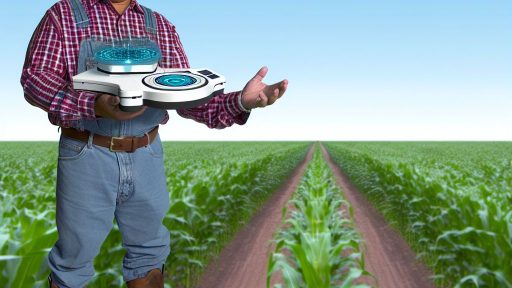Introduction to Controlled Environment Agriculture
Controlled Environment Agriculture (CEA) represents a vital shift in modern farming.
This innovative approach maximizes productivity while minimizing resource use.
CEA encompasses various technologies and methods for growing plants indoors.
Farmers can create optimal growing conditions regardless of outdoor climates.
Therefore, CEA enhances food security and resilience in agricultural systems.
Benefits of Controlled Environment Agriculture
One significant benefit of CEA is the ability to produce crops year-round.
This constant production helps stabilize food supply chains.
Moreover, CEA drastically reduces the need for pesticides and herbicides.
As a result, food quality often improves under controlled conditions.
Farmers also experience higher yields per square foot of growing space.
Technologies Used in CEA
Various technologies drive the success of Controlled Environment Agriculture.
Hydroponics allows farmers to grow plants in nutrient-rich water solutions.
Aeroponics employs misting techniques to deliver nutrients and water to plant roots.
Furthermore, vertical farming utilizes stacked layers to maximize space efficiency.
Each method offers unique advantages depending on the specific farming goals.
Transform Your Agribusiness
Unlock your farm's potential with expert advice tailored to your needs. Get actionable steps that drive real results.
Get StartedImpact on Environmental Sustainability
CEA plays a crucial role in enhancing environmental sustainability.
This approach significantly reduces water usage compared to traditional farming.
Additionally, CEA lowers carbon footprints by minimizing transportation needs.
Local production in urban areas decreases the reliance on long supply chains.
Thus, CEA supports the shift towards sustainable food systems globally.
Overview of Key Technologies in Controlled Environment Agriculture
Hydroponics
Hydroponics is a method of growing plants without soil.
This technique uses nutrient-rich water to nourish plants.
Farmers can grow various crops quickly and efficiently.
Additionally, hydroponics allows for precise control over nutrients.
As a result, yields often exceed traditional farming methods.
It is also space-efficient, making it ideal for urban areas.
Many farmers appreciate its potential for sustainability.
This method reduces water usage by up to 90 percent.
Aeroponics
Aeroponics takes hydroponics a step further.
This technique involves growing plants in an air or mist environment.
Roots dangle freely without any medium, receiving nutrients through mist.
As a result, plants grow faster and healthier.
Aeroponics uses even less water compared to hydroponics.
Furthermore, it minimizes disease risks due to reduced contact with soil.
This method is perfect for growers looking for innovative solutions.
Aquaponics
Aquaponics combines aquaculture and hydroponics in a symbiotic relationship.
This system allows fish waste to nourish plants effectively.
In return, the plants help purify the water for the fish.
This sustainable cycle creates a balanced ecosystem.
Showcase Your Farming Business
Publish your professional farming services profile on our blog for a one-time fee of $200 and reach a dedicated audience of farmers and agribusiness owners.
Publish Your ProfileAquaponics enables growers to produce fish and vegetables simultaneously.
Farmers enjoy multiple revenue streams from this integrated approach.
Moreover, aquaponics generally requires less water than traditional agriculture.
Farmers face fewer pests and diseases in these controlled conditions.
Benefits of Controlled Environment Agriculture for Farmers
Enhanced Crop Yield
Controlled Environment Agriculture (CEA) significantly boosts crop yields for farmers.
Using precise environmental control, farmers can optimize conditions for growth.
This leads to higher productivity every growing cycle.
Farmers can produce a consistent supply of crops regardless of outside conditions.
Ultimately, this technology helps meet increasing food demand.
Improved Resource Efficiency
CEA enables farmers to utilize resources more efficiently.
Water usage is minimized through advanced irrigation systems.
These systems deliver water directly to plant roots.
Moreover, nutrient application is more targeted, reducing waste.
This efficiency leads to lower operational costs for farmers.
Commitment to Sustainability
Implementing CEA practices promotes sustainable farming.
Reduced resource consumption lessens the environmental impact.
Moreover, energy-efficient technologies support eco-friendly operations.
Farmers contribute to reducing greenhouse gas emissions through CEA.
Additionally, they can cultivate crops without harmful pesticides.
Market Opportunities and Profitability
CEA allows farmers to tap into new markets.
They can produce specialty crops that command higher prices.
Also, farmers can grow crops year-round, increasing revenue potential.
This diversification reduces economic risk associated with traditional farming.
Ultimately, CEA promotes a profitable farming future.
Uncover the Details: AI-Based Soil Health Analysis Tools
Challenges of Implementing Controlled Environment Agriculture Technologies
Cost Considerations
Implementing Controlled Environment Agriculture (CEA) technologies can be expensive.
Initial investments often include infrastructure, equipment, and technology integration.
Farmers face high startup costs that can deter adoption.
Moreover, ongoing operational costs can strain budgets.
Consequently, financial support and resources are crucial for many farmers.
Technology Integration
Integrating CEA technologies into existing farming systems presents challenges.
Compatibility with current tools can be an obstacle for farmers.
Additionally, the variety of available technologies can overwhelm users.
Farmers must assess which technologies best fit their specific needs.
Therefore, training and support are key to successful integration.
Skill Gaps
There is a significant skills gap in the agriculture industry.
Many farmers lack knowledge about advanced CEA systems and their operation.
This gap hinders the effective use of innovative technologies.
Training programs are essential to equip farmers with necessary skills.
Furthermore, ongoing education can foster confidence in using new tools.
Showcase Your Farming Business
Publish your professional farming services profile on our blog for a one-time fee of $200 and reach a dedicated audience of farmers and agribusiness owners.
Publish Your ProfileDelve into the Subject: Smart Farming Solutions Through Controlled Environment Agriculture
Role of Automation and Robotics in CEA
Enhancing Efficiency
Automation streamlines various agricultural processes within controlled environment agriculture.
Advanced technologies reduce the time required for tasks like planting, watering, and harvesting.
As a result, farmers can produce crops faster and optimize their output.
With improved efficiency, farms can scale up operations seamlessly.
Efficiency gains lead to higher yields with less resource depletion.
Reducing Labor Costs
Robotics in agriculture significantly reduces the need for manual labor.
Many farmers face challenges related to labor shortages.
With robotic solutions, they can maintain productivity levels without hiring additional staff.
Automated systems can operate continuously, minimizing downtime.
Types of Automation Technologies
Several automation technologies are revolutionizing CEA.
- Automated irrigation systems ensure precise water application.
- Robotic harvesters reduce physical labor during peak seasons.
- Drones monitor crops and assess health from above.
Furthermore, these technologies provide real-time data to farmers.
Data-driven insights allow better decision-making and resource management.
Case Studies of Successful Implementations
Some farms successfully integrated automation and robotics.
GreenField Farms adopted robotic systems for harvesting tomatoes.
As a result, they increased their output by 30% with fewer workers.
AgriTech Solutions used drones for crop monitoring.
This technology helped them identify issues quickly, enhancing overall crop health.
Future Prospects
The future of CEA looks promising with continuous advancements in automation.
Emerging technologies will further reduce costs and increase efficiency.
As the technology matures, it will become more accessible to smaller farms.
Integration of robotics will redefine agricultural practices.
Find Out More: Blockchain Technology Improving Supply Chain Transparency For Farmers

Comparison of Traditional Agriculture vs. Controlled Environment Agriculture
Understanding Traditional Agriculture
Traditional agriculture relies heavily on natural weather patterns.
This method can be inconsistent across different climates.
Farmers face challenges such as droughts and floods.
Additionally, pests can devastate crops quickly.
Overall, traditional farming is often less predictable.
Exploring Controlled Environment Agriculture
Controlled Environment Agriculture (CEA) uses technology to manage conditions.
This approach allows farmers to grow crops year-round.
CEA minimizes risks associated with weather fluctuations.
Moreover, it can optimize resource usage significantly.
Crops can grow in ideal conditions regardless of the external climate.
Comparative Climate Adaptability
In arid climates, CEA shows distinct advantages.
Farmers can efficiently use water through hydroponics.
Traditional farming struggles in such dry regions, often resulting in crop failures.
On the other hand, CEA protects plants from severe weather events.
This adaptability leads to more reliable yields.
The Impact of Urbanization
Urban areas benefit significantly from CEA technologies.
These systems support local food production close to consumers.
Showcase Your Farming Business
Publish your professional farming services profile on our blog for a one-time fee of $200 and reach a dedicated audience of farmers and agribusiness owners.
Publish Your ProfileTraditional agriculture requires more land and transportation logistics.
Urban farmers can reduce carbon footprint through CEA practices.
As cities grow, this method becomes increasingly relevant.
Cost Considerations
Investing in CEA technology can be high initially.
However, lower operational costs can offset this expense over time.
Traditional farming often involves seasonal labor costs that fluctuate.
CEA provides consistent operational practices, reducing labor variability.
Ultimately, cost efficiency is a significant factor for many farmers.
Environmental Sustainability
CEA promotes environmental sustainability through resource efficiency.
It significantly reduces land use compared to traditional agriculture.
This method also decreases pesticide and fertilizer dependency.
Consequently, CEA can lead to lower environmental degradation.
Farmers using CEA actively contribute to sustainable production.
See Related Content: Integrating Biotechnology With Traditional Farming Methods
Case Studies of Successful CEA Implementations
Innovative Practices in the Netherlands
In the Netherlands, many farmers are leading in controlled environment agriculture (CEA).
They utilize greenhouses equipped with advanced technology.
For instance, GreenTech Farms optimized their greenhouse to regulate temperature and humidity.
This enhancement boosted crop yields significantly.
Furthermore, they integrated hydroponics systems to maximize space efficiency.
Such systems allow for higher density planting.
As a result, they can produce lettuce and tomatoes all year round, independent of external weather conditions.
Vertical Farming in Singapore
Singapore offers another impressive example of CEA in action.
The city-state faces land scarcity, pushing farmers towards vertical farming solutions.
Sky Greens, a leading vertical farm, uses an innovative A-frame system.
This system utilizes a fraction of the land traditional farms require.
Additionally, the farm employs solar panels to power its operations sustainably.
This approach minimizes dependence on fossil fuels.
The result is a significant reduction in water usage, innovatively adapting to the urban landscape.
Aquaponics in Australia
In Australia, farmers are exploring aquaponics as a sustainable CEA method.
This system combines aquaculture with hydroponics effectively.
One well-known example is Barramundi Farms, which raises fish alongside vegetables.
The waste produced by the fish nourishes the plants.
This symbiotic relationship ensures minimal resource waste and healthier produce.
By integrating aquaponics, these farmers experienced higher efficiency and improved biodiversity.
Indoor Farming in Canada
Canadian farmers are adopting indoor farming techniques to combat harsh winters.
These farms utilize LED technology to simulate natural sunlight.
Okanagan Specialty Fruits exemplifies this method, producing non-browning apples indoors.
They manage to create ideal growth conditions year-round.
This approach caters to market demands for fresh produce regardless of seasonality.
Moreover, their methods reduce pesticide use, contributing to healthier food options.
Showcase Your Farming Business
Publish your professional farming services profile on our blog for a one-time fee of $200 and reach a dedicated audience of farmers and agribusiness owners.
Publish Your ProfileCircular Economy in Sweden
Swedish farmers are harnessing the principles of the circular economy within CEA.
They recycle waste products from agriculture to support new growth.
An example is the BioFarm project, where farm waste produces biogas and nutrient-rich compost.
This compost then enriches the growing substrate for next season’s crops.
This sustainable cycle enhances efficiency while reducing environmental impact.
Farmers see both economic and ecological benefits from this innovative approach.
Future Trends in Controlled Environment Agriculture Technologies
Vertical Farming
Vertical farming offers a revolutionary approach to agriculture.
This method maximizes space in urban and rural areas.
Farmers grow crops in stacked layers, enhancing yield.
Additionally, vertical farms require less water than traditional farms.
This technique also reduces the need for pesticides.
Consequently, crops grow faster and healthier.
Furthermore, vertical farms can be located close to consumers.
This proximity reduces transportation emissions.
Technologies like hydroponics and aeroponics are prevalent in these systems.
They optimize nutrient delivery and plant growth conditions.
Smart Sensors
Smart sensors are transforming how farmers monitor their crops.
These devices collect real-time data on soil and environmental conditions.
Farmers can access information about humidity and temperature remotely.
This data enables more informed decision-making regarding irrigation.
Moreover, smart sensors can detect diseases and pest infestations early.
With alerts, farmers can take preventative measures promptly.
As a result, crop losses are minimized.
Smart sensors contribute to resource efficiency as well.
They help optimize water and fertilizer usage.
IoT Integration
Internet of Things (IoT) integration significantly enhances farming practices.
This technology connects various devices and systems in agriculture.
For example, IoT can link sensors, devices, and farming equipment.
This connectivity allows for automated systems that increase efficiency.
Farmers benefit from AI-driven analytics powered by IoT data.
Such insights improve yield predictions and crop management.
Additionally, IoT enhances precision farming techniques.
Farmers can use targeted approaches for planting and fertilization.
Overall, IoT integration supports sustainable farming initiatives.
It enables better resource allocation and environmental impact reduction.




